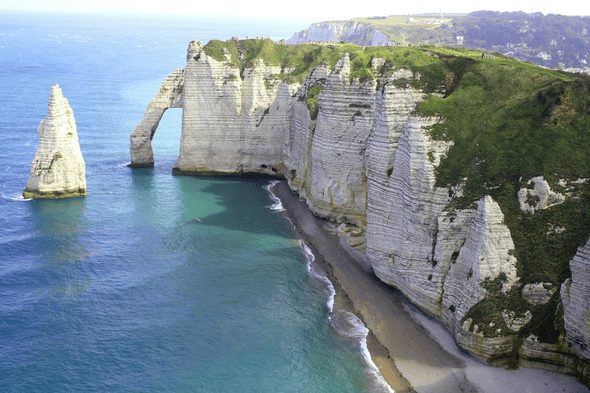Limestone:
Dating & Isotopic Analyses
Limestone is a granular sedimentary rock predominantly composed of calcium carbonate (CaCO3), which commonly forms along shallow ocean water beds from fossilized shells and exoskeletons of marine organisms. Additional minerals inherent within limestone include magnesium and iron carbonates (MgCO3, FeCO3), pyrite (FeS2) and quartz (SiO4). Rich in fossils, limestone is found in a variety of different forms depending on the formation location, including chalk (soft carbonates common in Europe) and travertine (a terrestrial form developed along mineral springs).

Dating Limestone
Limestone deposits can be dated using a variety of different methodologies, including Radiocarbon (14C), Uranium-Thorium (U-Th), and Strontium (Sr-Sr) dating – applicable to 0-50,000 cal BP, 0-500,000 cal BP, and 0-6,000,000 cal BP, respectively. The most optimal dating methodology depends on the sample era and depositional environment.
Radiocarbon dating is often perceived as the most reliable dating method due to its potential for high certainty and high temporal resolution of carbon-bearing samples; however, it does rely on the assumption that the sample has remained in equilibrium with the atmosphere. Thus, marine limestone samples are subject to the marine reservoir effect, which must be corrected for as part of the dating process, reducing the certainty of potential date ranges. Significant work has been undertaken to establish regional marine calibrations available on the Marine20 Database (Heaton et al. 2020). In many cases, 14C dating is used in combination with U-Th dating to reduce uncertainties (Paterne et al. 2004).
U-Th dating applies to any calcium carbonate material from the present day to approximately 500,000 years before present. This dating methodology depends on the assumption that the sample is a closed system – meaning that it has not exchanged significant matter following deposition, ensuring that the uranium and thorium have remained unchanged during diagenesis. Limestone deposits are sometimes considered to be open systems, which can result in aberrant ages.
Finally, Sr-Sr dating allows one to date marine samples up to 6 million years before present with a time resolution of 1 million years. This dating method is based on the assumption that marine carbonates uptake oceanic strontium isotope ratios (87Sr/86Sr) equivalent to that of the ocean during their lifespan and, therefore, should be equal to the average oceanic 87Sr/86Sr ratio at a distinct period of time. As such, the 87Sr/86Sr ratio within any marine carbonate sample (including limestone) can be matched with the Strontium Seawater Curve to determine a likely age range. This dating methodology allows for the dating of samples over a more extensive time horizon than 14C or U-Th dating, but is limited by the relatively high uncertainty (typically +/- 1 million years).
Stable Isotopes in Limestone
Boron (δ11B) Isotopes are an important variable in reconstructing past ocean conditions due to the correlation between fractionation of δ11B with variations in oceanic pH and CO2, both of which tend to vary during climate oscillations, including recent anthropogenic climate change and ocean acidification. Hence, the analysis of boron isotopes in limestone and other marine carbonates can be instrumental in investigating past ocean variations.
Beyond dating purposes, 87Sr/86Sr measurements applied to limestone samples can provide detailed information on the origin and migration of groundwater as well as intra-aquifer connectivity as water passes through different regions of a watershed as limestone (and other aquifer rock substrates) retain distinct strontium isotopic signatures which are reflected in groundwater via erosion.
The quantity of limestone required for dating and isotopic analysis varies as follows:
| Analysis Type | Sample Quantity | Recommendations |
| Radiocarbon (14C) Dating | 100mg in ziplock bags |
Please list the appropriate DeltaR / DeltaRErr (localized reservoir correction) for the area of collection so that we can provide the most appropriate calendar calibration for the result. |
| Uranium-Thorium (U-Th) Dating | 100mg in ziplock bags |
Please list the appropriate DeltaR / DeltaRErr (localized reservoir correction) for the area of collection so that we can provide the most appropriate calendar calibration for the result. |
| Strontium (Sr-Sr) Dating | 100-150 mg in plastic vials, microcentrifuge tubes, or counting slides |
For the best results, make sure your samples are clean and free from clay particles and other detritus. |
| Boron (δ11B) Isotopes | 300mg in plastic vials |
For the best results, make sure your samples are clean and free from clay particles and other detritus. Must be received dry and homogenized or extra charge will be applied, please contact the lab. |
| Strontium (87Sr/86Sr) Isotopes | 100mg in ziplock bags |
Clean & free from soil, clay particles, calcite and other detritus. Must be received dry and homogenized or extra charge will be applied. |
Contact us to discuss your limestone samples!
Image: https://www.pexels.com/photo/rock-cliff-near-seashore-534049/
References
- Heaton, T.J., Köhler, P., Butzin, M., Bard, E., Reimer, R.W., Austin, W.E., Ramsey, C.B., Grootes, P.M., Hughen, K.A., Kromer, B. and Reimer, P.J., 2020. Marine20—the marine radiocarbon age calibration curve (0–55,000 cal BP). Radiocarbon, 62(4), pp.779-820.
- Paterne, M., Ayliffe, L.K., Arnold, M., Cabioch, G., Tisnérat-Laborde, N., Hatté, C., Douville, E. and Bard, E., 2004. Paired 14C and 230Th/U dating of surface corals from the Marquesas and Vanuatu (sub-equatorial Pacific) in the 3000 to 15,000 cal yr interval. Radiocarbon, 46(2), pp.551-566.
